ABOUT VILLAS AND GARDENS
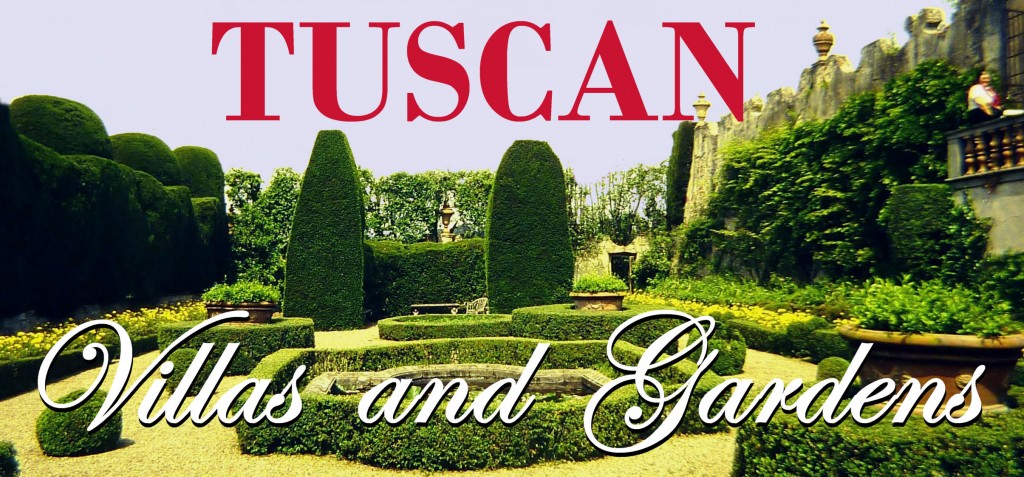
FUNCTIONS OF THE TUSCAN VILLA. The forerunners of Tuscan villas were fortified farmhouses with battlements and tall watch towers, so their owners had advance warning of approaching enemies. These farmhouses were surrounded by olive groves, orchards, vegetable gardens and vineyards, but they lacked pleasure gardens. The master's house, the overseer's and peasants' dwellings and outbuildings were closely grouped around a courtyard, so that it provided a stronghold in case of trouble. During the 14th and 15th century many of these fortified farmhouses or castles were transformed or replaced by 'livable' residences in keeping with the spirit of the times.
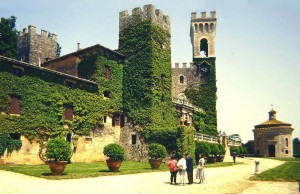
Celsa, a 14th century castle, converted into a 'livable' villa several centuries later.
Sales of wine, olives and olive oil paid the owners for the upkeep of their farm and for the wages of the peasant workers. At the time the Tuscan villa was expected to produce enough to contribute to the income of the landlord's family living in the city, as well as sustain all the sharecroppers who toiled the soil (the overseer and the peasants lived on the property in hovels).
For the owner the villa only became an appealing place for recreation and leisure during the summer.
During the 13th and 14th centuries, Tuscany experienced a period of intensive commercial activity. Florence's merchant families.(e.g. the Medici) increased their wealth by aggressive trading and banking.
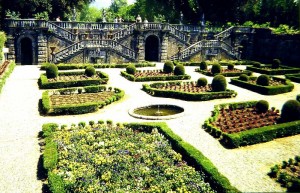
Typical Secret Garden at Villa Torrigiani
When the merchants of Tuscany became even wealthier in the 14th century, they turned to the Arts to display their wealth and power. The so called 'learned merchants' commissioned famous architects to refurbish their town and country houses and to build additional villas on the hills of Tuscany. Now they preferred the life of country gentlemen and cloistered in small secret gardens to devote their time to more spiritual pursuits.
Early 16th century, the wars that tore Italy apart were responsible for a decline in the power of the Tuscan merchants as they faced tough competition, especially from Spain and Portugal.
When peace was restored by Cosimo I, he created a new influential class of civil servants, who began to invest their money in land. Cosimo I also encouraged a general exodus to the country. This trend led to the establishment of new country villas. In less than fifty years the number of villas increased tenfold .The main function of this new type of villa was no longer farming, but as a place for gracious living and entertainment . Most owners returned to their palazzi's in Florence only in the winter months. This lifestyle continued throughout the 16th and 17th centuries.
In 1815, after the Napoleonic period, a new vogue for antiquity and ruins inspired travellers (mostly writers and artists from England, Holland and Germany) to wander around Italy, the cradle of Western civilisation. Many fell in love with Tuscany and bought villas. They preserved their Renaissance character while enriching them with paintings, sculpture and other art objects.
Since Antiquity most villas were built on elevated sites, providing beautiful views and a symbol of domination. In the 14th century a theory on the ideal placement for a villa was developed with regard to layout, architecture and landscaping, which was generally based on a geometrical and axial plan.
Today, the people who choose to live in Tuscan villas come from many different backgrounds and made their choice for their own specific reason.
OWNERS OF TUSCAN VILLAS. In later years wealthy American and British expatriates were attracted to the very beautiful areas of Fiesole and Settignano and purchased large handsome Renaissance villas there. Unfortunately, most of these villas have thick stone walls without damp courses, making them chilly and damp in winter. Many lacked any form of plumbing or heating and needed extensive restoration.
Russian Grand Dukes, American billionaires and eccentric British aristocrats expended time and money to restoring crumbling villas and tangled gardens to Renaissance splendour.
GARDENS AND WOODS. The main purpose of the medieval gardens was to meet the needs of the household and produce vegetables and fruits. But by the middle of the 13th century the master arranged to have a small enclosed private garden adjacent to his country house. The garden, while keeping its utilitarian character, began to be appreciated for its beauty. The 'secret garden' with its geometrical layout, inspired by ancient Roman models, was reborn.
The Tuscan garden of the early Renaissance remained simple. Besides orchards, beds of vegetables and lawns, the garden consisted of a plot of ground where several unpaved walks divided ornamental parterres bordered by orange and lemon trees in large terracotta pots. It could be enhanced by a small stone fountain, crowned by a statuette, a fish pond, a vine- or rose-covered pergola, benches and bowers. In some instances a patch was planted with fragrant herbs and medical plants, such as juniper, rosemary, bay and myrtle. The garden progressively became a place for enjoyment and contemplation.
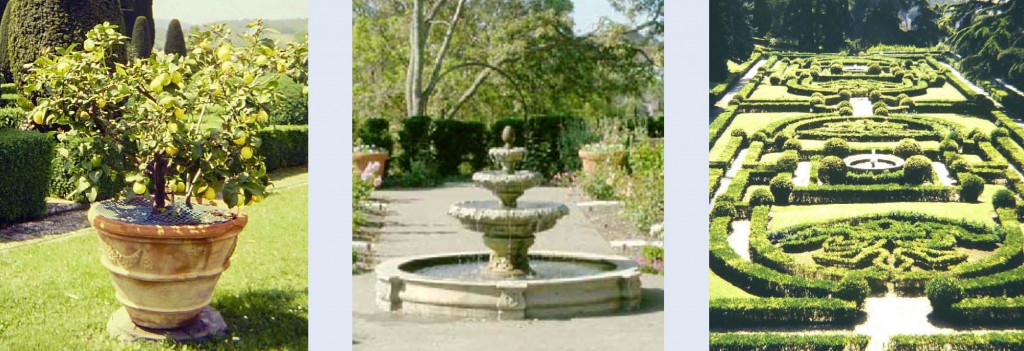
In the 15th century, gardeners rediscovered the art of topiary — pruning boxwood, yews, cypress and ilex trees into geometrical shapes or to form walls of greenery around the parterres. Greenery was trimmed into the shape of battlements or animals to provide theatrical backdrops of foliage or to form intricate mazes and imaginative patterned parterres. Walks bordered with geometrically clipped box bushes created vistas. High hedges formed enclosures called exedras. Also trees were trained to make foliage roofs over walks with interlacing branches — nature was being tamed and bridled. Stone elements began to appear amongst the greenery — grottos made of pumice or tufa covered with sea shells, mossy imitation rocks, fountains, cascades and ornate ponds with sprays and jets, pavements of pebble mosaics and statues adorned the gardens.
The garden was designed along strict geometrical principles, using simple forms, such as squares, rectangles, circles and semi-circles. The grounds were divided into different sections, arranged independently and symmetrically along axis. Sloping sites were used advantageously by levelling off the terrain into successive terraces, separated by retaining walls and monumental staircases. These types of gardens (hanging gardens) often opened up to the surrounding landscapes with breathtaking views from the loggias of the villas. The original Tuscan garden is characterised by a predominance of greenery and water features. There is a balance between the 'artificial Nature' of the man-made garden and the 'natural Nature' of the untouched woods beyond.
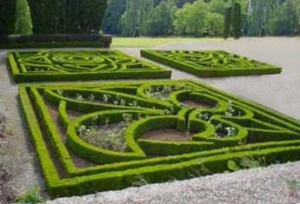
Example of a Parterre de Broderie
The great garden art of the Renaissance inspired many imitations during the 17th and 18th century. At that time some of the characteristics of the classical French gardens were borrowed, with parterres no longer shaped in geometrical patterns, but adopting curvilinear lines, or parterres de broderie. As a result of the introduction of increasingly varied species of plants, the gardens became more colourful, thereby losing the severe and formal character of the predominant 'green' Renaissance gardens.
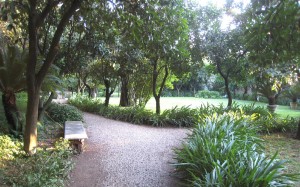
Example of a English style garden.
In the 19th century owners of the Tuscan villas began to convert their gardens according to new fashions imported from England and France. The English, who began to colonise the hillsides of Tuscany, destroyed many of the old gardens, thereby reducing the cost of maintenance. Unfortunately the Italians themselves were influenced by this trend towards the English style. A new school of gardeners tore out the parterres, created vast lawns, laid out winding paths in no particular pattern and planted scattered groves that formed elements entirely foreign to the Tuscan climate and soil. The English introduced flowering plants, such as the camellia, the azalea, the rhododendron, the wisteria and the Banksia rose. As a result only a few unaltered Renaissance and Baroque gardens can be found near Florence today.
Ironically, it was the English who returned to the original formal layouts at the beginning of the 20th century. They commissioned landscape architects to redesign or restore existing Tuscan gardens accordingly.
Today, many of the remaining Tuscan villas are still faithful to their 14th century image as a place of tranquility and privacy. Hidden in the hills behind high walls or a curtain of trees, they are often hard to reach. Only if you have an adventurous spirit, you will be able to discover their secrets.
These historic houses with their large and splendid gardens often have fascinating histories. Over the centuries Tuscan villas have been the setting of conspiracies, murders, and adulterous affairs.
